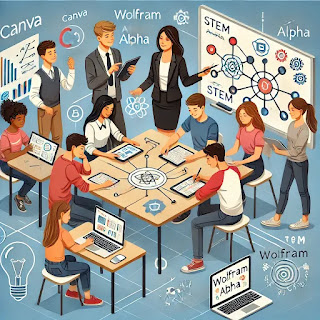AI Practice for Teacher Educators Day 52: AI for Cross-Disciplinary Teaching
Integrating AI into Cross-Disciplinary Education
AI tools can facilitate cross-disciplinary teaching by connecting diverse fields, fostering collaboration, and creating innovative learning experiences. Today, we’ll explore how AI can bridge subjects and engage students in transdisciplinary thinking.
Why Use AI for Cross-Disciplinary Teaching?
-
Encourages Connections:
- AI supports projects that combine concepts from multiple disciplines.
-
Inspires Innovation:
- Facilitates creative solutions by integrating diverse perspectives.
-
Enhances Collaboration:
- Encourages teamwork across subject areas for a holistic approach.
-
Supports Complex Problem-Solving:
- Tackles real-world challenges requiring interdisciplinary knowledge.
AI Tools for Cross-Disciplinary Teaching
-
Canva for Education:
- Supports collaborative projects by combining design, science, and storytelling.
-
Google Workspace with AI Features:
- Provides tools for collaborative research, writing, and presentations.
-
ChatGPT:
- Assists with brainstorming, generating interdisciplinary lesson plans, and summarizing complex topics.
-
Wolfram Alpha:
- Integrates data and insights from STEM and humanities disciplines.
-
MindMeister:
- Helps map connections and organize ideas across subjects.
Practical Activity: Design a Cross-Disciplinary Project with AI
-
Choose a Theme or Challenge:
- Focus on real-world issues that require input from multiple disciplines (e.g., climate change, urban planning).
-
Select AI Tools:
- Example: Use Canva for collaborative presentations combining visuals and data.
- Example: Use MindMeister to map out project ideas and connections.
-
Plan the Workflow:
- Divide tasks among students with roles representing different subject areas.
-
Reflect and Share:
- Present findings, emphasizing how interdisciplinary thinking shaped solutions.
Sample Workflow
Project: Designing a Sustainable City (STEM, Social Studies, and Art)
- Tools: ChatGPT, Canva, and Wolfram Alpha
- Process:
- Use ChatGPT to brainstorm city planning concepts.
- Research data on energy efficiency and urban design with Wolfram Alpha.
- Create a visual presentation of the city plan using Canva.
Reflection Questions
- How did AI tools support cross-disciplinary connections in the project?
- What skills did students develop through this approach?
Handy Tip: Emphasize Real-World Applications
- Connect interdisciplinary projects to real-world contexts to enhance relevance and engagement.
Next Steps
- Resource Suggestion: Explore "AI for Interdisciplinary Teaching" by EdTech Magazine for additional tools and strategies.
- Foster transdisciplinary learning with AI tools that connect concepts, inspire creativity, and prepare students for complex challenges!
